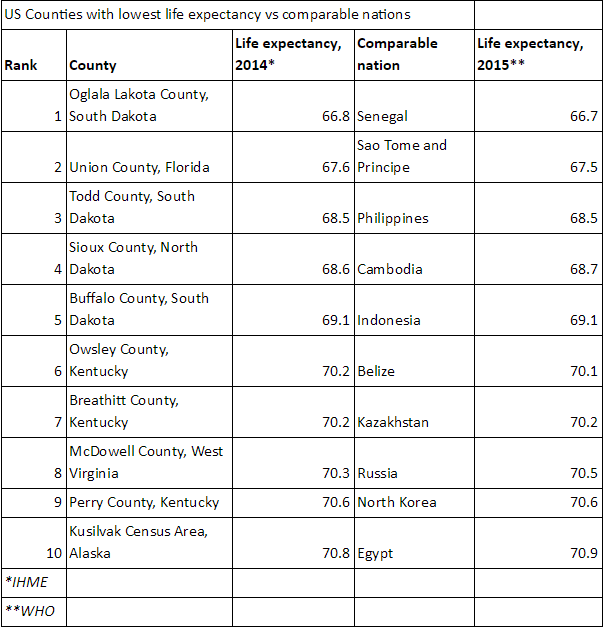Some parts of the US have a lower life expectancy than Iraq and North Korea

New research reveals a gap of more than 20 years between the US counties with the highest and lowest life expectancies. Image: REUTERS/Mike Blake
Despite being the world’s largest economy, some parts of the US have health records that compare unfavourably with developing nations, war-torn countries and dictatorial regimes.
New research examining death records across US counties reveals that those living in areas with the highest life expectancy can expect to live for more than 20 years longer than those living in areas with the lowest life expectancy.
At just 66.8 years, Oglala Lakota County in South Dakota had the lowest life expectancy of any county investigated by the University of Washington’s Institute for Health Metrics and Evaluation (IHME).

This is a lower life expectancy than for people living in Iraq (68.9 years), according to World Health Organization (WHO) data. Meanwhile residents of Perry County, Kentucky, ranked ninth-lowest county in the US, have a life expectancy equivalent to North Koreans (70.6 years).
In fact the 10 US counties ranked lowest by IHME all scored life expectancies of around 70 years of age or lower – putting them behind countries such as Bangladesh (71.8) and Libya (72.7).

In stark contrast, people living in US counties with the highest levels of life expectancy are among the most statistically likely to live longer than anyone anywhere in the world.
All of the top 10 US counties in IHME’s ranking have life expectancies close to 84 years, faring better than the world’s three “healthiest” countries in which to live, according to the WHO: Japan at 83.7 years; Switzerland at 83.4 years; and Singapore at 83.1 years.

The differences in life expectancy across the US of up to 20 years have been highlighted by IHME researchers in a paper in the medical journal JAMA Internal Medicine entitled Inequalities in Life Expectancy Among US Counties, 1980 to 2014.
The paper looks at not only current differences in life expectancy, but also whether life expectancy has increased with time.
While the majority of US counties saw life expectancies rise over the 24-year period examined – the two biggest increases coming from counties in Alaska, both up by around 18% – there were 13 counties where life expectancy actually fell.
Of the 13 counties to suffer declining life expectancy, eight were in the US state of Kentucky. The biggest fall was seen in Owsley County, where life expectancy dropped by 3%.
These findings follow a report by the US Centers for Disease Control and Prevention, which found that in 2015 for the first time in 22 years overall life expectancy actually fell, albeit marginally.
Beyond healthcare
The US is by far the world’s biggest spender on healthcare, yet research repeatedly shows that it lags behind other developed nations on measurements of health such as life expectancy.
In their paper the IHME researchers conclude that healthcare provision is less significant than socioeconomic factors when explaining the huge variations seen in life expectancies across US counties.
They claim that only 27% of the variations could be explained by healthcare factors, while 60% could be explained by “socioeconomic and race/ethnicity factors”.
Speaking to CNN, lead author of the study Dr Christopher J.L. Murray notes that “many of the counties with very low life expectancies in the Dakotas, like Oglala Lakota County in South Dakota, overlap with large Native American reservations including the Pine Ridge and Rosebud reservations”.

Murray adds that both low and high life expectancies are likely the result of a combination of exposure to quality healthcare and socioeconomic factors, as well as prevalence of metabolic risk factors such as large waistlines and high blood pressure.
Murray and his IHME colleagues in their paper conclude that more should be done at policy level to target these factors and help close the US life expectancy gap.
“Policy action targeting socioeconomic factors and behavioral and metabolic risk factors may help reverse the trend of increasing disparities in life expectancy in the United States,” they say.

Don't miss any update on this topic
Create a free account and access your personalized content collection with our latest publications and analyses.
License and Republishing
World Economic Forum articles may be republished in accordance with the Creative Commons Attribution-NonCommercial-NoDerivatives 4.0 International Public License, and in accordance with our Terms of Use.
The views expressed in this article are those of the author alone and not the World Economic Forum.
Stay up to date:
United States
The Agenda Weekly
A weekly update of the most important issues driving the global agenda
You can unsubscribe at any time using the link in our emails. For more details, review our privacy policy.
More on Health and Healthcare SystemsSee all
Evan Spark-DePass
November 14, 2024







